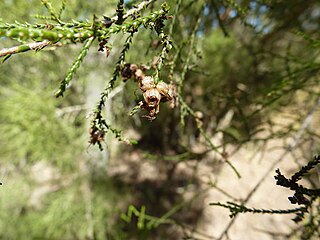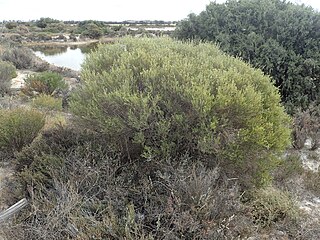
Melaleuca is a genus of nearly 300 species of plants in the myrtle family, Myrtaceae, commonly known as paperbarks, honey-myrtles or tea-trees. They range in size from small shrubs that rarely grow to more than 16 m (52 ft) high, to trees up to 35 m (115 ft). Their flowers generally occur in groups, forming a "head" or "spike" resembling a brush used for cleaning bottles, containing up to 80 individual flowers.

Regelia is a genus of flowering plants in the family Myrtaceae and is endemic to the south-west of Western Australia. The genus is composed of five species of small leaved, evergreen shrubs which have heads of flowers on the ends of branches which continue to grow after flowering. Another species, previously known as Regelia punicea and which is endemic to Kakadu National Park in the Northern Territory, has been transferred to Melaleuca punicea.
Melaleuca penicula is a plant in the myrtle family, Myrtaceae and is endemic to the south of Western Australia. It is a rare species only known from the Fitzgerald River National Park and resembles Melaleuca eximia with its spikes of red flowers but its leaves and stamen bundles are different.

Melaleuca atroviridis is a plant in the myrtle family, Myrtaceae and is endemic to the south-west of Western Australia. It was formerly included in the species Melaleuca uncinata but a review of that species lead to the identification of a number of new species. Like M. uncinata, this species is used for the production of brushwood fencing. It has fewer stamens in the flowers and somewhat smaller clusters of fruit but has the same needle-like leaves with a hooked end and spikes of creamy yellow flowers in early summer.

Melaleuca barlowii is a plant in the myrtle family, Myrtaceae and is endemic to the south-west of Western Australia. It is similar to a number of other Western Australian melaleucas such as M. conothamnoides with its purple pom-pom flower heads but is a more erect shrub with different leaves and the fruiting clusters have a different shape.
Melaleuca eximia is a plant in the myrtle family, Myrtaceae and is endemic to the south of Western Australia. It is distinguished by its leaf arrangement, its large, showy red inflorescences and the large, furry bracts under the flowers.

Melaleuca exuvia is a plant in the myrtle family, Myrtaceae and is endemic to the south of Western Australia. It is easily distinguished by its unusual rough, minni ritchi bark which peels to reveal a new layer of smooth, salmon-pink bark. It is a newly described (2004) species which was formerly included in Melaleuca uncinata.

Melaleuca interioris is a plant in the myrtle family, Myrtaceae and is endemic to Western Australia, South Australia, Queensland, New South Wales and the Northern Territory. It was formerly included in Melaleuca uncinata and is similar to that species with its cylinder-shaped leaves and small heads of yellow flowers, but with smaller, less compressed fruiting capsules.

Melaleuca monantha is a plant in the myrtle family, Myrtaceae and is endemic to an area in Queensland, Australia. It is a shrub, similar to Melaleuca minutifolia with very small leaves but the leaves lack oil glands and its flowers occur singly, rather than in pairs. It is also similar to Melaleuca sylvana but is usually multi-stemmed and has a more dense crown than that species.

Melaleuca osullivanii is a plant in the myrtle family, Myrtaceae and is endemic to the south-west of Western Australia. It was first formally described in 2004 after a review of the broombush group, Melaleuca uncinata. It differs from others in the group by having leaves that are fine and circular in cross section. The closest other broombrush is Melaleuca hamata whose leaves are 0.8–1.6 mm (0.03–0.06 in) in diameter compared to 0.7–0.9 mm (0.03–0.04 in) for this species.

Melaleuca scalena is a plant in the myrtle family, Myrtaceae and is endemic to the south west of Western Australia. Plants of this species were previously included in Melaleuca uncinata or broombush until a review of that species in 2004. Its leaves are narrow cylinders, the flowers in small yellow heads and the fruits tightly packed together in oval clusters. This species is very similar to Melaleuca hamata but the plants have a comparatively scruffy or less strong and healthy appearance.

Melaleuca vinnula is a plant in the myrtle family Myrtaceae and is endemic to the south-west of Western Australia. It is a shrub with narrow leaves, heads of white to yellow flowers followed by tight clusters of fruit and it is found in the wheatbelt. It is a newly-described species from a review of the group of melaleucas known as broombrush.

Melaleuca zeteticorum is a shrub in the myrtle family Myrtaceae and is endemic to the south-west of Western Australia. It is a shrub with narrow leaves and pale to bright yellow flowers in spring. Its species name zeteticorum was given "in honour of these persons who for their enjoyment explore natural vegetation communities to become familiar with their constituent species".

Melaleuca strobophylla is a shrub or small tree in the myrtle family Myrtaceae and is endemic to the south-west of Western Australia. It has papery bark, sharply pointed, twisted leaves and rather long spikes of creamy white flowers in summer.

Melaleuca apostiba is a shrub in the myrtle family, Myrtaceae and is endemic to the south-west of Western Australia. It was first described in 1990 by Kirsten Cowley and remains a poorly known species. It resembles Melaleuca lateritia except for its hairy leaves and flower structures as well as its leaf shape and size.

Melaleuca lecanantha is a plant in the myrtle family, Myrtaceae and is endemic to a small area of south-west Western Australia. It is a shrub with small, rather fleshy leaves and pink to lilac-coloured flowers in early spring. The plant was first described in 1867 but the name given to it was considered illegitimate and it was not until 1998 that it was first formally described.

Melaleuca camptoclada is a shrub in the myrtle family, Myrtaceae and is endemic to the south-west of Western Australia. It was first described in 1990 in a review of the genus Melaleuca when the species Melaleuca laxiflora at that time was found to comprise ten species. Two of those species were new - M. camptoclada and M. ctenoides.
Melaleuca citrolens, commonly known as gulbarn, is a plant in the myrtle family, Myrtaceae and is endemic to northern Queensland and the north-eastern part of the Northern Territory. Plants in this species were originally included in Melaleuca acacioides until a review of the genus in 1986.

Melaleuca ctenoides is a shrub in the myrtle family, Myrtaceae and is endemic to the south-west of Western Australia. It was first described in 1990 in a review of the genus Melaleuca when the species M. laxiflora at that time was found to comprise ten species. Two of those species were new - M. camptoclada and M. ctenoides. It similar to Melaleuca laxiflora but distinguished from it by its comb-like leaves and attractive mauve or violet flowers in spring.
Melaleuca triumphalis is a plant in the myrtle family, Myrtaceae and is endemic to the Victoria River district of the Northern Territory in Australia. It was discovered on a 1996 expedition commemorating the work of the early German-Australian botanist, Ferdinand von Mueller. It is a shrub with grey foliage and contrasting green heads of flowers in spring.
















